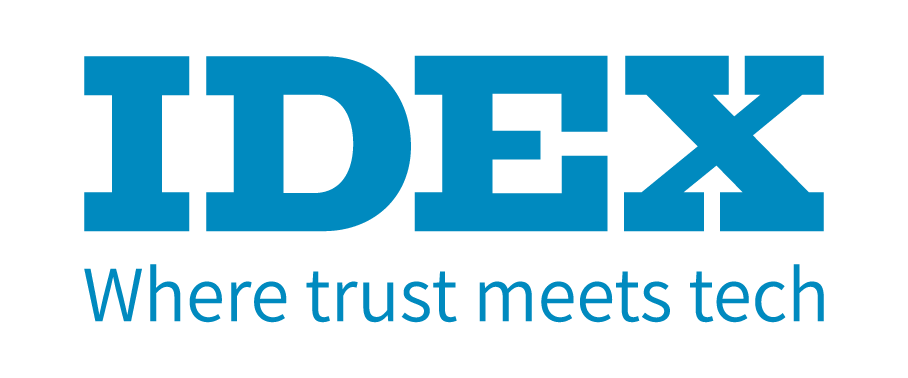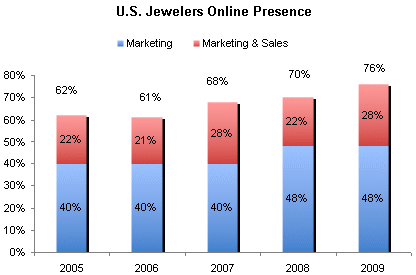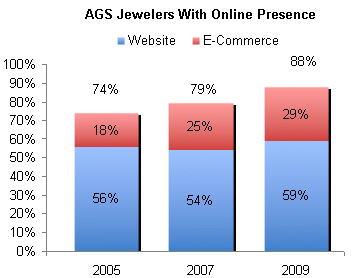IDEX Online Research: Best Jewelry Customers Are Online
June 01, 10
The number of U.S. jewelers with a website continues to rise modestly, but those who can actually sell product remains stubbornly low. In contrast, internet usage by U.S. shoppers – especially those who are most likely to buy diamonds and jewelry – continues to increase significantly.
The opportunity is clear: jewelers need to proactively use their website to achieve two key goals, especially if they hope to reach those consumers who are most likely to make purchases online:
· Drive customers into their store
· Sell merchandise online
Online Sales Up in 2009, Despite Recession
Store-based merchants were the victims in the recent recession. While Total U.S. retail sales fell by 7.3 percent in 2009, online retail sales rose by 1.6 percent, according to figures released recently by the U.S. Department of Commerce.
Among jewelers, the disparity was even greater: total jewelry sales fell by a modest 1.6 percent in 2009, but online jewelry sales increased by a stellar 10.7 percent to $2.7 billion.
The table below summarizes total U.S. retail sales, online retail sales, jewelry sales and online jewelry sales for 2009.
Retail Sales Category $ Billions 2009 Sales % Chg Y/Y Total U.S. Retail Sales $3,671.2 (7.3%) Total U.S. E-commerce Sales $144.1 +1.6% Total U.S. Jewelry Sales $59.0 (1.6%) Total U.S. Specialty Jewelers’ Sales $28.3 (4.2%) Total U.S. Jewelry E-Commerce Sales $2.7 +10.7%
Based on the data in the table above, e-commerce sales were 3.9 percent of total retail sales, and jewelry e-commerce sales were 4.6 percent of total U.S. jewelry sales.
One of the perennial perplexing questions which jewelers ask is this: “If jewelry has to be romanced – typically by a well-trained store sales person – to be sold, how come online jewelry sales represent a greater portion of jewelry industry sales versus the ratio of total online retail sales to total retail sales?”
The answer is quite simple: an estimated 70 percent of all online jewelry sales are diamonds and diamond jewelry, both of which carry a very high average ticket.
For example, Blue Nile’s average ticket is about $1,800, and its average ticket for a diamond engagement ring is about $5,900. This is in contrast to the average ticket for a mass market specialty jeweler of about $300-350, and the average ticket for an AGS jeweler of about $1,100. Further, the average ticket for a diamond engagement ring for a store-based specialty jeweler is about $4,500. Most store-based jewelers’ sales mix consists of about 50 percent diamonds, sharply lower than the 70 percent mix of online merchants.
Jewelers’ E-Commerce Efforts Have Hit a Plateau
In 2007, about 28 percent of all U.S. jewelers used the internet for both marketing and sales (e-commerce). That number declined in 2008, and was flat at 28 percent in 2009. While the number of jewelers who have an internet presence has increased, those who are e-commerce enabled seem to have hit a plateau, as the graph below illustrates. The good news is that the total number of jewelers with an online presence has increased from 62 percent in 2005 (40 percent for marketing plus 21 percent for marketing & sales) to 76 percent in 2009 (48 percent for marketing and 28 percent for both marketing and sales).

Source: Jewelers of America Cost of Doing Business Survey
The trend is somewhat more positive among AGS jewelers; these jewelers represent about 5 percent of total specialty jewelers in the U.S. and are more upscale than the typical jeweler. Their methods of doing business are more professional, and they subscribe to a tough, comprehensive code of ethics.
The graph below illustrates both the online presence and the e-commerce enabled jewelers among AGS members. Nearly nine out of ten AGS jewelers have a presence online while only about three-fourths of all specialty jewelers are represented online. However, in terms of e-commerce, about 29 percent of all AGS jewelers offer merchandise online, about in line with the total universe of U.S. specialty jewelers’ level of 28 percent (as shown on the graph above).

Source: AGS
Online Usage Continues to Rise
Consumers in 76.6 percent of all U.S. households could access the internet from some location at the end of 2009, according to the U.S. Census Bureau. This is up from 71 percent in 2007, just two years earlier.
Broadband internet penetration has risen even faster. At the end of 2009, 63.5 percent of all households had broadband internet providing quick access to the internet, up substantially from 50.8 percent in 2007.
The Opportunity for Jewelers
The demographic profile of consumers whose jewelry expenditures are the largest is the same demographic profile of consumers with the highest internet usage.
For example, based on education levels, a whopping 93 percent of all consumers with a college degree have access to the internet, versus just fewer than 77 percent for the total population. This group of highly educated consumers spends about $827 annually per-household on jewelry, versus just $497 for the total population.
In short, jewelers’ best customers are also the heaviest users of the internet. Smart jewelers will target those high-spending shoppers with an internet presence – preferably an e-commerce presence.
The tables below summarize internet usage by some key demographic factors versus annual spending by each of the demographic segments.
Age of Online Users
Older, more mature consumers – those age 55 and older – are much less likely to use the internet than younger consumers. Historically, this was the consumer group that spent the most on jewelry. In recent years, younger consumers make greater expenditures on jewelry. Thus, jewelers should be targeting younger consumers who shop online. The annual jewelry expenditures are for the year 2008, the latest data available.
Age of Consumer % Using Internet Annual Jewelry Expenditures All U.S. Consumers 76.7% $497 Under 25 Years 82.9% $328 25-34 Years 85.6% $665 35-44 Years 87.0% $458 45-54 Years 83.7% $563 55 Years & Older 63.9% $445
Ethnicity of Online Users
Asian consumers have the highest participation rate in online usage – nearly 86 percent – and their per-household jewelry expenditures are also the greatest of any ethnic group – about $623 annually. The problem: Asians represent only 4 percent of the total U.S. households. White households have nearly a 78 percent participation rate for internet usage, and their annual per-household jewelry expenditures are $566. White non-Hispanic households represent about 70 percent of all U.S. households; thus, this market is large enough to be targeted efficiently and effectively by merchants.
The table below summarizes internet participation and annual jewelry per-household jewelry expenditures by ethnicity.
Ethnicity of Consumer percent Using Internet Annual Jewelry Expenditures All U.S. Consumers 76.7 percent $497 White 77.7 percent $566 Black 68.1 percent $291 Asian 85.5 percent $623 Hispanic 63.9 percent $249
Educational Level of Online Users
Is mentioned above, better-educated consumers are online in droves. Research also confirms that the more education a consumer has, the more they will spend on jewelry.
The table below summarizes internet participation and jewelry expenditures by education level in the U.S. market.
Education of Consumer % Using Internet Annual Jewelry Expenditures All U.S. Consumers 76.7% $497 Less than High School Graduate 41.0% $183 High School Graduate 66.2% $325 Some College / Associate Degree 83.9% $497 Bachelor’s Degree or Above 93.0% $827